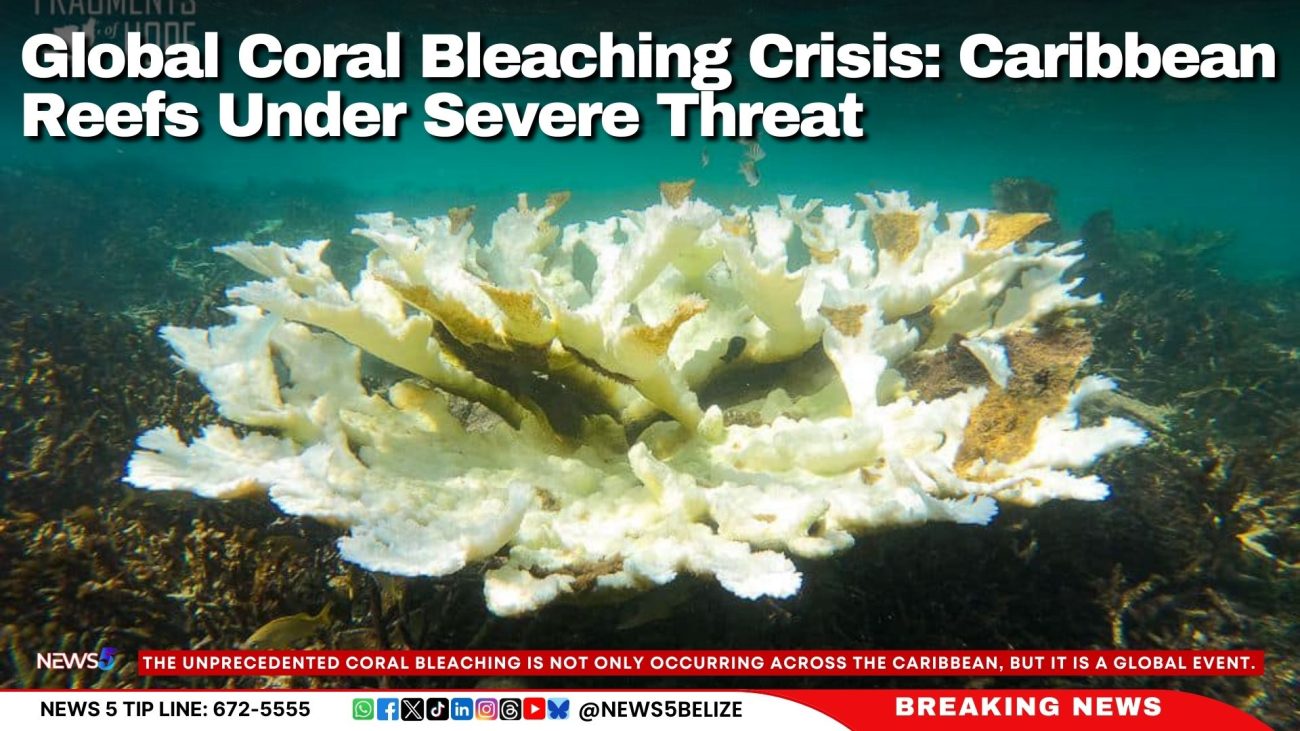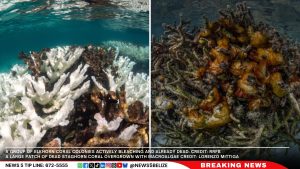Global Coral Bleaching Crisis: Caribbean Reefs Under Severe Threat
A reef of at least 4,000 years old died in Vega Baja, Puerto Rico, between November and December 2024. This is according to Edwin Alexis Hernández, a research affiliate at the University of Puerto Rico, Río Piedras Campus, and senior research scientist at Sociedad Ambiente Marino. He issued a chilling wake-up call following the catastrophic loss. “What you see here no longer exists… because of record-breaking sea surface temperatures, degree heating weeks, and massive coral bleaching,” Hernández said. “These are highly endangered Elkhorn corals (Acropora palmata). They are now >99% gone! In a blink of an eye! This is called climate change! Are you sceptical? Well, here you go! Are we going (again) to do nothing about it and pretend nothing has just happened? Or are we going to step forward and do something about it this time?” he added.
According to Hernández, even with the most intensive restoration efforts, it will take 20 to 30 years to rebuild what was lost—if that’s possible.

Hundreds of nautical miles south of Puerto Rico, coral reefs in Bonaire are being devastated by bleaching. Reef Renewal Foundation Bonaire (RRFB) says that rising ocean temperatures, which reached record highs across the Caribbean in both 2023 and 2024, have inflicted widespread damage on nearly every coral species around the island. A comprehensive seven-year study conducted by Stichting Nationale Parken Bonaire (STINAPA) revealed a sharp increase in corals affected by thermal stress, jumping from 25% in 2016 to over 80% in 2023. “The scale of bleaching is evident across reefs around the island, with widespread impacts on nearly every coral species.”
In Belize, coral bleaching has worsened. Northern Belize has already seen significant coral loss, and while southern areas are faring slightly better, experts warn that without drastic action, similar outcomes are likely. Fragments of Hope, an organisation dedicated to restoring coral reefs across Belize, has shifted its focus in recent years due to escalating sea temperatures. With each year hotter than the last, the group has paused coral restoration efforts for the past two years, instead prioritising coral bleaching surveys. The decision stems from the heightened risk of mortality for stressed corals under such extreme conditions. Monique Vernon, a coral reef practitioner with Fragments of Hope, said the bleaching in southern Belize in November is “off the charts.” She added, “At Laughing Bird (Caye), along which has been the Fragments of Hope control site, it’s really sad to see, because since 2006, Fragments of Hope has been restoring corals there, and the corals have been doing wonderfully, but this year, they bleached, and they died, and unfortunately only a few of them are recovering.”
The unprecedented coral bleaching is not only occurring across the Caribbean, but it is a global event.
NOAA Confirms Fourth Global Coral Bleaching Event
The National Oceanic and Atmospheric Administration (NOAA) confirmed in April the 4th global coral bleaching event. Derek Manzello, Ph.D., NOAA CRW coordinator, said, “From February 2023 to April 2024, significant coral bleaching has been documented in both the Northern and Southern Hemispheres of each major ocean basin.”
According to NOAA, mass bleaching has affected tropical coral reefs worldwide, including regions such as Florida, the Caribbean, Brazil, the eastern Tropical Pacific (encompassing Mexico, El Salvador, Costa Rica, Panama, and Colombia), Australia’s Great Barrier Reef, large areas of the South Pacific (Fiji, Vanuatu, Tuvalu, Kiribati, the Samoas, and French Polynesia), the Red Sea, the Persian Gulf, and the Gulf of Aden. Widespread bleaching has also been reported in the Indian Ocean basin, including Tanzania, Kenya, Mauritius, the Seychelles, Tromelin, Mayotte, and parts of Indonesia.
Manzello said, “As the world’s oceans continue to warm, coral bleaching is becoming more frequent and severe…When these events are sufficiently severe or prolonged, they can cause coral mortality, which hurts the people who depend on the coral reefs for their livelihoods.”
The summer of 2023 was the hottest on record globally, with sea surface temperatures in the North Atlantic and Caribbean reaching unprecedented levels.
What is Coral Bleaching?
Coral reefs are among the most diverse and valuable ecosystems on the planet. Though they occupy only 1% of the world’s oceans, these ecosystems provide critical habitats for at least 25% of all marine life. According to NOAA, coral reefs support over 4,000 species of fish, corals, and other organisms.
Beyond fisheries, coral reefs bolster local economies through tourism and recreation. “Coral reefs support jobs and businesses through tourism and recreation. Local economies receive billions of dollars from visitors to coral reefs through diving tours, recreational fishing trips, hotels, restaurants, and other businesses located near reef ecosystems,” NOAA said in a statement.

Coral reefs are also pivotal in medical research. According to NOAA, compounds derived from coral reef organisms have led to the development of treatments for cancer, arthritis, bacterial infections, and other diseases.
So coral reefs are extremely important, and addressing coral bleaching in a timely manner is critical. Coral bleaching occurs when corals, stressed by changes in conditions such as temperature, light, or nutrients, expel the symbiotic algae living in their tissues. This causes the corals to turn white and, if the stress continues, can lead to their death. Vernon said, “Consider the corals like the forest, the rainforest of the sea. Without the trees, there are no birds, right? And a dead ecosystem has no life. So there’s no reason for fisThe fishesgo there. The that we have in Belize, they’re very colorful. So when you go to any dead reef, you can see, you can easily find the fishes. They’re not easily camouflaged anymore because the corals are all dead. They’re not colourful anymore, so they can’t camouflage in. And because the corals are dead, the strength of the corals is lost, which means they’re very, they’re even more fnow, which now, means the stability for fishes to hide in it decreases. It’s like you’re living in an abandoned house that no one takes care of, basically.”
Vernon explained that corals can only survive within a specific temperature range. When the water temperature falls too low or rises too high, the corals experience stress. She said that corals are animals that house algae, a plant that lives inside them. This algae enables the corals to photosynthesise and gives them their vibrant colors. However, when the water temperature becomes too warm, the algae perceives the environment as too stressful and expels itself from the coral. This process leaves the coral pale or white, but it doesn’t necessarily mean the coral is dead. “Until there are macroalgae that start to grow on top of that coral, that’s when we know for sure it’s dead. We’ve seen corals that turn fully white, and they bounce back and gain their colour again. Those are what we consider thermally resilient corals,” Vernon said.
Restoring Hope
Earlier this year, in April and June, Fragments of Hope trained 23 Belizeans in coral identification and bleaching surveys with the aim to cover more ground across Belize’s various dive sites, such as Laughing Bird Caye, and to increase local community involvement in the organisation’s mission. “So what they are trying to focus on is locating those thermally resistant corals so that they can start propagating those across Belize. And when I say corals, I’m talking about the acroporidae species: elkhorn, staghorn, and fud staghorn. orn.Those are faster-growing corals than the boulder corals,” Vernon shared.
But is this enough?
“I mean, there’s only so much we can do. If we could get a tent to put and shade these corals, you know, but it’s not realistic. And the only thing that we can do is train Belizeans to help us go out and source these corals, thermally resistant corals, to get more of those out on the ground. And next year, we’re actually going to add fish identification to the list. So that more people can get more involved with those surveys as well.”

Despite these efforts, public and governmental attention to the crisis remains limited. Many view the Belize Barrier Reef, the second largest in the world, as intact from surface observations, but underwater surveys reveal extensive coral death and algae overgrowth.
The loss of corals has wide-reaching implications, not just for biodiversity but also for tourism and fisheries. Laughing Bird Caye, for instance, saw coral coverage rise from 6% after Hurricane Iris to over 60% following restoration, only to experience significant loss again this year. Without corals, fish populations decline, affecting food security and livelihoods. Vernon said, “If we lose our barrier reef just at Laughing Bird Caye alone, where there were so many, I mean, after the 2001 hurricane, Iris, that had, like, destroyed corals, it was left down to 6 percent, and fragments of hope restored those corals. Recently to over 60%. And so now those corals are almost all dead. And that’s why I feel like more emphasis needs to be put on this because that’s a national park, and most people go there. And now there’s not even as many fish; you know, more corals equal more fish, and with dying corals, I mean, the fisheries population can also see a shift as well.”
In Bonaire, RRFB “is working to strengthen coral populations at a biological level and build resilience against these threats.” According to RRFB, during the peak bleaching season, it intensifies its monitoring efforts to pinpoint resilient coral colonies. Between October and December, their team dedicated over 150 hours to surveying 25 reef sites around the island in search of “super corals.” Once identified, these corals are nurtured in nurseries, outplanted to the reef, and incorporated into RRFB’s coral breeding program, allowing them to pass on their resilient traits to future generations.
Meanwhile in Puerto Rico, a research team of divers partnered with the Institute for Socio-Ecological Research (ISER Caribe) focused on installing suspended habitats for baby Diadema antillarum, the long-spined sea urchin, a species crucial to coral regeneration by controlling harmful algae. ISER Caribe has launched the Caribbean Reef Project, which aims to restore 5 acres of coral reef in Puerto Rico by employing an ecosystem-based approach that not only targets coral restoration but also addresses the rehabilitation of herbivores vital to coral reef health. The project will restore six coral reefs across Fajardo, La Parguera, and Mayagüez by outplanting 20,000 coral fragments, 1,600 sea urchins, and 100 crabs at each site. The team’s efforts are vital in the battle against coral decline, and their work is an essential part of preserving Puerto Rico’s fragile marine ecosystems.
The stakes are high, but coordinated international action offers hope for the future of these vital ecosystems.








Facebook Comments